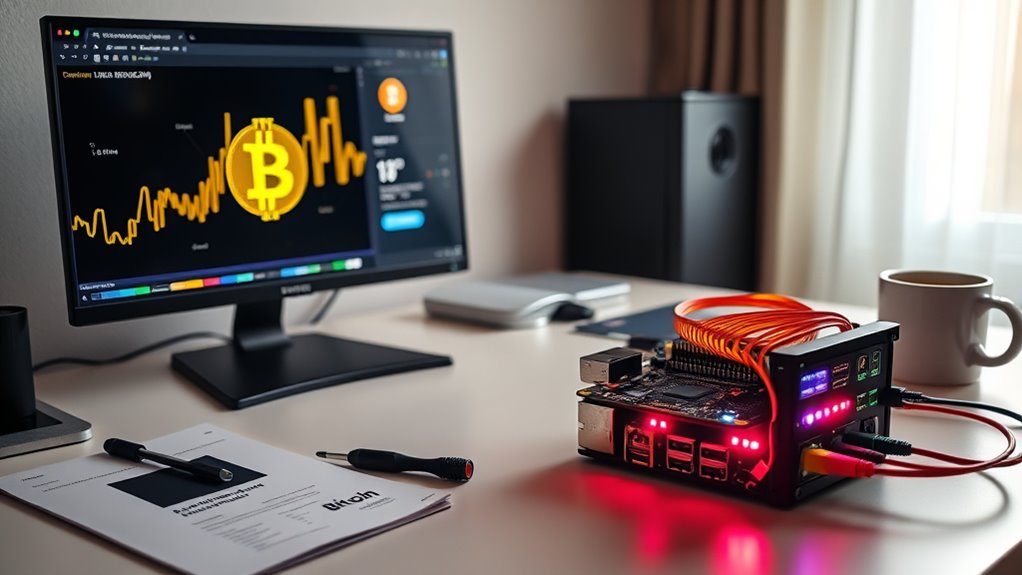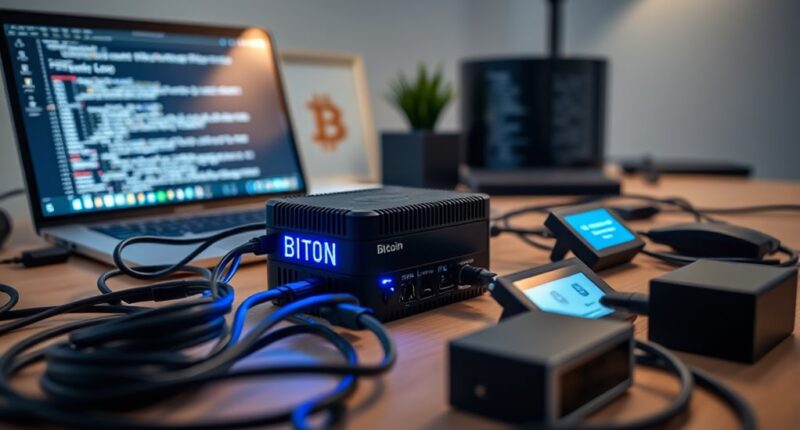To run a full Bitcoin node at home, start by choosing a suitable hardware setup with a 4-core processor, at least 8 GB of RAM, and a 1 TB SSD to store the blockchain. Install your preferred operating system, like Linux for stability, and make certain your internet connection is reliable with high bandwidth. Keep your device powered continuously, disable sleep modes, and regularly check disk health. If you keep going, you’ll discover detailed steps to set everything up properly.
Key Takeaways
- Ensure your hardware meets minimum requirements: a 4-core CPU, 8-16 GB RAM, and at least 1 TB SSD storage.
- Choose a compatible operating system, preferably Linux, and set up the necessary software like Bitcoin Core.
- Maintain a stable, high-speed internet connection with sufficient bandwidth and keep the node running 24/7.
- Properly configure your network with port forwarding and security measures to allow inbound connections.
- Regularly monitor disk health, keep software updated, and consider using a pruned node to save storage space.

Running a full Bitcoin node at home is a practical way to support the network and enhance your privacy. To get started, you’ll need suitable hardware. A 4-core processor, such as an Intel E3v6 or i3 equivalent, provides good performance, with higher GHz per core offering more benefits than simply increasing core count. Begin with at least 4 GB of RAM, but 8 to 16 GB is recommended, especially if you plan to run additional services alongside your node. Storage is crucial; a solid-state drive (SSD) of at least 1 TB ensures enough space for the growing blockchain, which is around 350 GB as of 2025. If you opt for a pruned node, you can reduce storage needs to under 5 GB by deleting older blocks. Any modern desktop or laptop running a current OS—Windows, macOS, or Linux—works fine. Linux is often preferred for stability and control, but Windows users can utilize Docker to run Lightning Network nodes if needed.
Running a Bitcoin node requires a 4-core CPU, 8-16 GB RAM, and at least 1 TB SSD storage for smooth operation.
Your internet connection plays an essential role. A steady broadband connection with upload/download speeds of at least 50 Kbps is the minimum, but a 100 Mbps connection with unmetered or high data caps is ideal. Full nodes may upload over 200 GB and download more than 20 GB monthly, so reliable, high-capacity plans are crucial. Connection stability and low latency improve block validation and network propagation, making for a more secure and efficient node. If you’re running Lightning Network services, a 100 Mbps connection helps maintain smooth operation without bottlenecks. Additionally, internet stability is critical; frequent disconnections can disrupt synchronization and slow down network participation. Maintaining a high-quality network connection ensures consistent performance and reduces the risk of data corruption or missed blocks.
Storage capacity and speed are equally important. An SSD with at least 100 MB/s read/write speeds ensures your node runs smoothly without bottlenecks during block validation. Keeping a buffer of about 1 TB accommodates future blockchain growth. Regularly monitor your disk health because intensive write activities can wear out drives over time. For long-term operation, consider setting up a pruned node if storage or bandwidth are concerns.
Power and continuous operation greatly influence your node’s reliability. Running your node 24/7 helps keep your blockchain sync up to date and supports the decentralized network. Disable sleep or suspend modes on laptops and desktops to prevent interruptions. Using an uninterruptible power supply (UPS) protects against power outages, ensuring your node stays online. On laptops, turn off power-saving features that might shut down your network connection or put the device to sleep. Longer runtime enhances network stability, improves wallet synchronization, and strengthens overall support for Bitcoin’s infrastructure.
Frequently Asked Questions
What Are the Hardware Requirements for Running a Full Node?
You need a 4-core CPU with high GHz per core for efficient processing, along with at least 2-4 GB of RAM—8 GB is better for stability. A solid-state drive with 1 TB of free space guarantees smooth synchronization, while a stable internet connection of at least 50 Kbps (ideally 100 Mbps) supports data transfer. These specs help your node run reliably, sync quickly, and support the Bitcoin network effectively.
How Much Does It Cost to Operate a Bitcoin Node Monthly?
Thinking about keeping your Bitcoin node humming? You’ll likely spend around $30 each month on electricity and a bit more on internet if you keep it running smoothly. Expect to dedicate a few hours weekly for maintenance and updates, but most of the time, it runs quietly in the background. If you choose cloud hosting, costs can jump considerably, so weigh convenience against your budget before deciding.
Can I Run a Full Node on a Mobile Device?
Running a full Bitcoin node on your mobile device isn’t practical. Mobile devices lack the processing power, storage, and network stability needed for reliable operation. Plus, operating a node requires significant bandwidth and continuous uptime, which mobile networks can’t consistently provide. Instead, consider running your node on a dedicated desktop or server, or use a remote hosting service to guarantee proper performance and security.
What Are the Security Risks of Hosting a Node at Home?
Hosting a node at home is like guarding a valuable treasure chest—your security is only as strong as your defenses. You face threats like malware, ransomware, and DDoS attacks that can compromise your operation. Physical risks include theft or damage, while network vulnerabilities expose your location and data. Without proper protections, you risk losing funds, privacy, and control, making it essential to implement robust security measures to safeguard your node.
How Do I Update or Troubleshoot My Bitcoin Node?
To update or troubleshoot your Bitcoin node, regularly check for the latest software releases on the official site and verify signatures before installing. Stop your node with `bitcoin-cli stop`, then upgrade and restart it. If issues arise, make certain you have enough disk space, check network connectivity, review logs, and monitor system resources. Restart the node or reindex with `-reindex` if problems persist. Keep your system and dependencies updated for smooth operation.
Conclusion
Running a full Bitcoin node at home might seem intimidating, but with patience and persistence, you can master it. Remember, Rome wasn’t built in a day, and neither is a robust node. Stay committed, follow the steps carefully, and you’ll soon enjoy greater privacy and control over your Bitcoin transactions. In the end, taking responsibility for your own nodes empowers you and strengthens the network—because a chain is only as strong as its weakest link.









